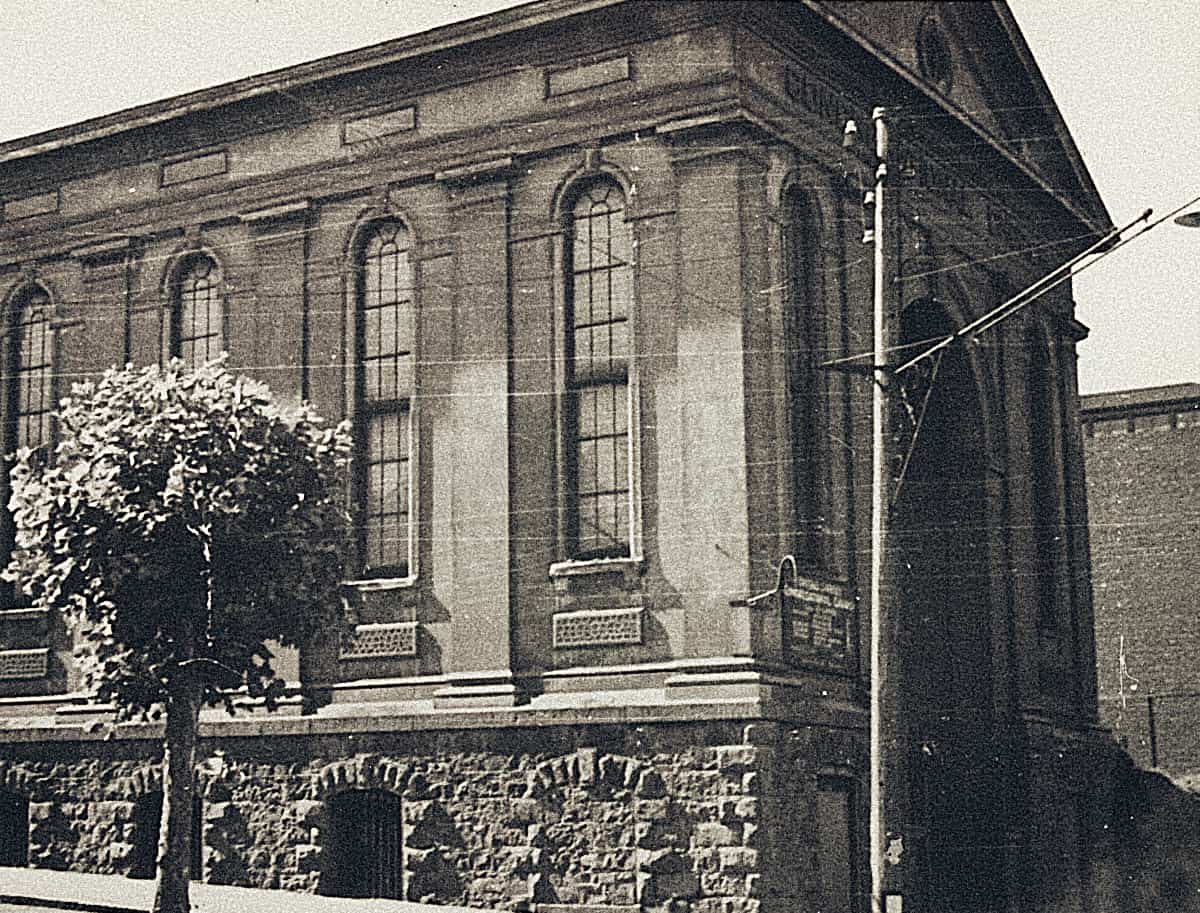

Congregational Church, Collingwood – exterior
(photographs by Colin Caldwell, from State Library of Victoria [c.1946-52])
Historical and Technical Documentation by John Maidment
© OHTA, February 2022


Congregational Church, Collingwood – exterior
(photographs by Colin Caldwell, from State Library of Victoria [c.1946-52])
Historical and Technical Documentation by John Maidment
© OHTA, February 2022
The Independent Chapel, or Congregational Church, Oxford Street, Collingwood, was opened in 1856.1 The architect was Alfred Taylor Snow and it was built in an austere classical style, with a prominent pediment, Doric pilasters and a central doorway surmounted by an arch. With falling congregations, the final service took place on 25 April 1948 and the building closed for worship. Bought by a Swanston Street store, it was demolished in 1952. Today, it would be regarded as an architectural treasure.

Congregational Church, Oxford Street, Collingwood –
the organ drawn by Graeme Rushworth from an article in Australasian Post, 6 May 1948
There are two press accounts relating to the opening of the organ:
“An organ, built to the order of the trustees of the Oxford-street Congregational Church, Collingwood, has just been completed by Messrs. R. McKenzie and Co., of 17 Collins-street east. The instrument, which is built after the Grecian style, contains eighteen stops in all, and its compass is C to G, fifty-six notes, that of the pedals being CCC to F. The pedal pipes are constructed on the latest improved principles, and have been imported specially for the instrument from the manufacturers in London. The organ case, which is twenty feet high, is composed entirely of clear pine, and is tastefully ornamented on the exterior. The total cost of the organ is £450, and it has taken a period of about three months to finish it. It is already erected in its place in the church, where a private trial of its powers was given last night. Several organists belonging to churches in and around Melbourne played upon it, amongst the number being Mr. Summers, who performed several selections from Handel and Beethoven, and expressed himself in high terms of approval of the instrument."2
“The new organ just erected by Messrs. McKenzie and Rinton [Renton] for the Oxford-street Congregational Church, Collingwood, was publicly opened lost night. A concert of sacred music was given on the occasion, before a tolerably numerous audience. The praises of the organ have already been sounded in these columns, and the performance of last night confirmed the good opinions previously formed concerning the instrument. Its tones are as mellow as an old cathedral organ ripe with age; there was no sticking of notes so common to new organs, and no uncertain sounds.
The compass of the organ is from CC to G, fifty-six notes; pedals, from CCC to F, thirty notes. The great organ contains nine stops : — Open diapason, stop diapason, dulciana, clarabella, principal, twelfth, fifteenth, clarionet, flute. The swell organ stops are : — Open diapason, stop diapason, principal, fifteenth, and oboe. The pedal organ, grand open diapason, 16 feet; three composition pedals, and three couplers, viz., swell to great, great to pedals, and swell to pedals. The instrument has cost £450, and promises to be one of the best organs yet made in the colony. There was a very satisfactory concert, the contributors to which were Mesdames Ramsden, Mortimer and Hilliard, Messrs. J. and E. Simmonds, Jowett, and a large chorus of voices, conducted by Mr. S. Kaye. Mr. Summers, Mus. Bac. Oxon., presided at the organ, and played half a dozen well chosen pieces, all of which legitimately belonged to the organ school, and were not operatic selections culled to suit a vicious public taste. In Mendelssohn's grand sonata No. 3 Mr. Summers's pedalling was quite a study, and in the andante movement from Beethoven's symphony in D the flute and clarionet stops were used with beautiful effect. Both are fine stops, worthy of any organ. The ladies sang particularly well; indeed, it is not often that such good voices are heard in public. The Hallelujah Chorus from the Messiah brought the concert to a close. There is a probability of a similar musical entertainment being given again shortly."3
| GREAT Open Diapason Stop Diapason Clarabella Dulciana Principal Flute Twelfth Fifteenth Clarionet Swell to Great |
8 8 8 8 4 4 2-2/3 2 8 |
CC-BB TC TC? |
|
| SWELL Open Diapason Stop Diapason Principal Fifteenth Oboe |
8 8 4 2 8 |
||
| PEDAL Grand Open Diapason Great to Pedal Swell to Pedal |
16 |
Compass: 56/30
Mechanical key and stop action
3 composition pedals to Great
3 composition pedals to Swell
George Fincham moved the organ from the rear to the front of the church in 1889.4 It is possible the extended mechanical action console was added at the time. The organ was uncomfortably placed in front of an impressive Doric-style structure, maybe a pulpit. The organ was hydraulically blown until 1939.
After the church closed, the organ was dismantled and stored at the Fincham factory in Richmond. It is believed that some parts may have been used in otherwise new organs, such as the slider chests and pipework, but the splendid classical case inevitably was destroyed.
1 Date researched by E.N. Matthews from church receipts. No account of the opening of the building can be located on Trove
2 The Age, 16 July 1874, p.2
3 The Age, 21 July 1874, p.2
4 E.N. Matthews, Colonial Organs and Organbuilders (Carlton: Melbourne University Press, 1969), p.128